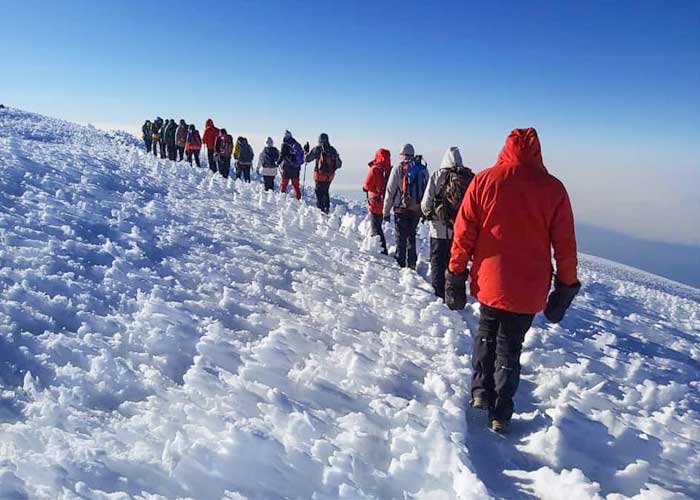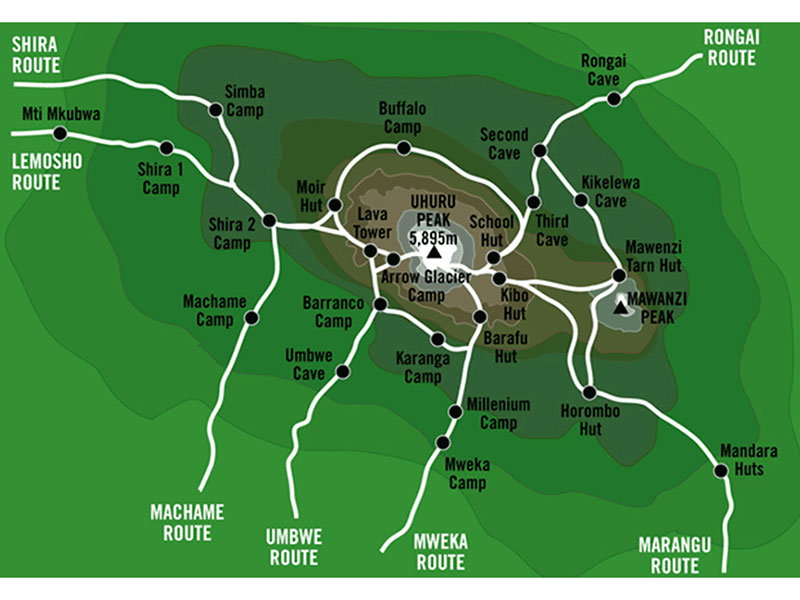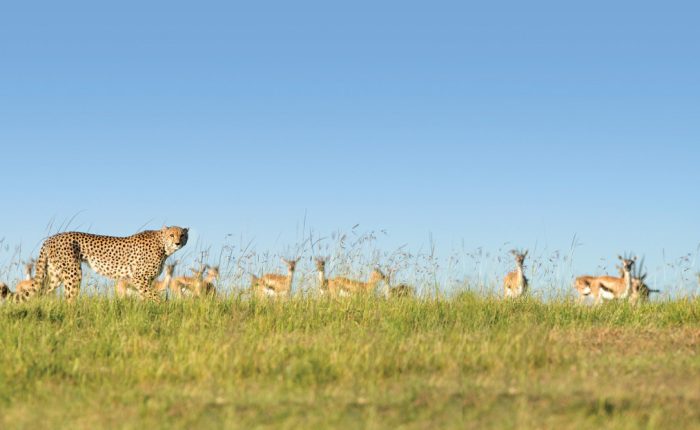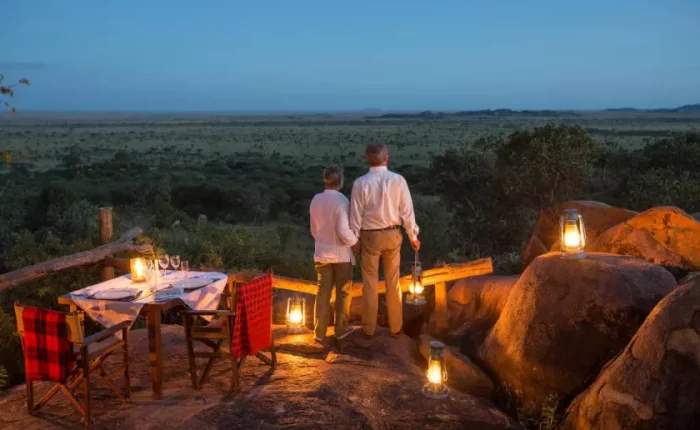Adding item to wishlist requires an account
Don't have an account? Create one.
Why Book With Us?
- No-hassle best price guarantee
- Customer care available 24/7
- Hand-picked Tours & Activities
- Best Safari Guides
Get a Question?
Do not hesitate to give us a call. We are an expert team and we are happy to talk to you.
+255 742 688 249
info@safarinugguets.com
8 Days Mount Kilimanjaro Northern Circuit
- 10 Days
- Max People : 25
- Min Age : 12+
- Pickup: Airpot
The Northern Circuit route is one of the best routes on Kilimanjaro, offering nearly 360 degrees of beautiful scenery including the quiet, rarely visited northern slopes. As the longest route on Kilimanjaro, the Northern Circuit also has the most acclimatization time and the highest summit success rate. Thus, the Northern Circuit route is highly recommended.
The route approaches Mount Kilimanjaro from the west, beginning with a long drive from Moshi to Londorossi Gate. From there, the first two days are spent trekking through the rainforest to Shira Ridge, before crossing the Shira Plateau. The route then heads north and circles clockwise from Moir Hut to Buffalo Camp to School Hut, before summiting from the east. Descend is made via the Mweka route.
Ultimate Kilimanjaro® offers the Northern Circuit as a nine day group climb or private climb. A 10 day variation that includes an overnight at Crater Camp is available as a private climb by special request.
Departure & Return Location
Arusha town (Google Map)
Departure Time
3 Hours Before Flight Time
Price Includes
- Airport Pickup & Transfer
- 3 Nights Hotel Accommodation in Arusha
- Kilimanjaro Tour Guide
- Entrance Park Fees
- Transport to and from the airport
- All meals per itinerary (B=Breakfast, L=Lunch, D=Dinner)
- All tours and entrance fees per itinerary (unless listed as excluded)
- Emergency Oxygen (2L canister)
- Oximeters
- All transportation and transfers per itinerary
- Camping fees
- Tents, foam sleeping pads, cooking equipment, and eating utensils
- Rescue fees (as required by national park)
- Certified, experienced, English-speaking guides for all routes
- Salaries for all crew members
Price Excludes
- International and domestic flights
- Beverages and alcohol
- Any Private Expenses
- Tips for guides, drivers, hotel staff
Complementaries
- Umbrella
- Kilimanjaro Coffee
- T-Shirt
Highlights of the 6-Day Mount Kilimanjaro on Rongai Route
- Experience the stunning views from Gilman’s Point and Kilimanjaro’s Uhuru Peak.
- Enjoy warm healthy meals and quiet campsites as you approach the summit.
- Birdwatch and look for monkeys in two different forest environments.
- Experience a more gradual ascent and the quieter paths on the first days of the Rongai Route.
Itinerary Day to Day
Day 1Arrival Kilimanjaro International Airport (JRO)
You will be met upon your arrival in JRO, and transfer to your hotel near the airport.
Accommodation and MealsBed & Breakfast – see options on the right
Day 2 Londorosi Gate (2,100 meters) – start point 2,360 meters to Mti Mkubwa Camp (2,820 meters)
The Northern Circuit Route begins at Londorossi Gate (2,100 meters) in the West, the same start points as the Lemosho Route. The drive to Londorossi Gate takes approximately two hours from Moshi and considerably longer from Arusha. Registration with the Kilimanjaro National Park authorities occurs at the gate and then you will be driven further up the mountain to the trailhead starting point. Most tour operators serve lunch here before the short first day trek to Mti Mkubwa Camp (2,820 meters) begins. You may get lucky and spot large wildlife like elephant and buffalo that sometimes emerge from the rainforest onto the path as you trek towards your first camp. Dinner will be served when you reach Mti Mkubwa Camp.
Day 3 Mti Mkubwa Camp (2,820 meters) to Shira Camp 1 (3,610 meters)
On day two you will spend the first-hour trekking through the last section of the rainforest path before entering the low alpine moorland zone which follows up onto the Shira Plateau. The trek is relatively short and gradual, ending at Shira Camp 1 (3,610 meters).
Day 4Shira Camp 1 (3,610 meters) to Moir Camp (4,200 meters)
On day three the trek crosses the Shira Plateau which is considered one of the highest plateaus on earth. You immediately veer away from the crowded trails and head towards the northeast edge of the Plateau to reach Moir Camp. Nine day trekkers usually spend the night at Shira Camp 2 where they will join trekkers from the Machame Route. At Shira Camp 2 it is worth trekking a little higher up the plateau to enjoy the stunning view across the valley below and Western Breach of Kilimanjaro above. The plateau is exposed so be prepared for a cold night with temperatures getting below zero. The trek takes about 5-7 hours over easy terrain. Moir camp is an isolated and rarely used camp affording stunning views over the Shira Plateau.
Day 5Moir Camp (4,200 meters) to Buffalo Camp (4,020 meters)
Day four involves a moderately steep climb out of Moir Valley. Trekkers can take a small detour here to climb the summit of Little Lent Hill at 4,375 meters before returning to the Northern Circuit trail. From here the route follows a series of inclines and declines, skirting around the northern slopes of Kibo to Buffalo Camp (4,020 meters).The trek gives great vistas out across the plains that lie north of Kilimanjaro and stretch out to the Kenyan / Tanzanian border. You will arrive at Buffalo Camp just after midday, where you will have lunch and have time to rest after a long day hiking.
Day 6Buffalo Camp (4,020 meters) to Rongai Third Cave (3,800 meters)
Day five starts with a climb up the Buffalo ridge and down into Pofu Camp where lunch is usually served. The route then continues east around the northern slopes to the Rongai Third Cave at 3,800 meters. The trek is shorter than the day before and by now you should be feeling well acclimatized to the altitude. You will arrive at the Third Cave just around mid-afternoon.
Day 73rd Cave (3,800 meters) to School Hut (4,800 meters)
Day six involves a steady incline up and over the Saddle which sits between the peaks of Kibo and Mawenzi Peak. Trekkers then continue walking south-west up to School Hut (4,800 meters). After arriving at School Hut you will be served an early dinner and then you should get some shut-eye as you will be awoken before midnight to start your summit attempt. Remember to prepare all your gear, including warm clothes, insulated water bottles, snacks, headlamp and camera before going to bed.
Day 8School Hut (4,800 meters) to Uhuru Peak (5,895 meters) and then onto Millennium Camp (3,950 meters)
You will be awoken around 11:30 with hot tea and biscuits and will then begin the steep incline up the slopes of Kibo under the cover of darkness. Your first check-point is Hans Meyer Cave where you will take a short break. The climb steepens as you approach Gilman’s Point (5,681 meters), which will be around 5-6 hours after departing School Hut. Take a moment to enjoy the approaching dawn and incredible view out and across to Mawenzi Peak, but remember you still have 2 hours trekking to reach Uhuru Peak so dig deep for the energy. The slope flattens as you head west around the crater rim and you should arrive at the summit at or just after sunrise. Your stay here will be brief so get as many pictures as you can of the incredible views and surrounding glaciers. You will then retrace your steps back around the crater rim to Stella Point (5,739 meters) where you will turn south and head down the heavily screed slopes of Kibo to Barafu Camp (4,680 meters). Most trekkers take a short break here before continuing down to Millennium Camp (3,950 meters) for your final night on the mountain. In total you will be trekking for 14-16 hours on day eight so it is important to pace yourself, remain hydrated and keep your blood sugar levels up.
Day 9Millennium Camp (3,950 meters) to Mweka Gate (1,640 meters)
The final day is a short hike through the dense montane rainforest from Millennium Camp (3,950 meters) to Mweka Gate (1,640 meters). At the gate you will need to sign-out with the authorities, who will also provide you with your official certificate – a green certificate for those who made it to Gilman’s Point and a gold certificate for those who reached Uhuru Peak. It is customary to give your guides and porters tips at this point before being driven back to your hotel in Moshi or Arusha.
Day 10Departure
Transfer to Kilimanjaro airport.
Kilimanjaro Route Map
FAQ
1) How much time do I need to climb Mount Kilimanjaro?
We recommend a minimum of eight days from the USA and Europe, although some people may wish more time for the trip. We can customize itineraries or routes to offer more days in the park(s). Some people may wish to climb nearby Mount Meru as well. If you have more than eight or nine days, you can choose any of the main routes on the mountain and still have time for a wildlife safari before or after your trip.
2) What is the best time of year to climb Mount Kilimanjaro?
You can climb any month of the year. At lower elevations, April, May, and November are quite wet while March and June are transitional months. August and September are the coldest and driest months. January, February, July, August, and September are all popular climbing months.
3) How far do I hike each day?
We can measure each day in walking hours rather than kilometers. Most days, other than the summit day, will begin with breakfast around 6:30 AM and departure at 7 AM. You will walk four to five hours with a break for lunch followed by another hour or two of hiking in the afternoon. These days are not long or difficult and you will be advised to walk slowly.
4) Why do we make the final ascent in the pre-dawn darkness?
Most groups will start for the summit on ascent day around 11 PM to midnight, depending on the perceived fitness of the group, the weather, and the route. The pre-dawn hours are ideal to start the ascent to the summit as it is cold but also calm and clear. It is rare to find cloudy weather at the summit at dawn any time of year and at dawn, you have the best view.
On the other hand, if you leave in the early morning, it could be very windy and the ascent becomes more difficult. The ascent day is a long hiking day, so it is better to start early and walk slowly. It can take up to 15 hours to reach the summit and descend to the camp for that night.
5) How much weight will I have to wear and where can I leave unnecessary luggage?
You will simply carry a day pack of about two to four kilograms, although some people carry more or less. Your gear (not to exceed twelve kilograms) will be placed inside a waterproof duffle at the trailhead and a porter will carry this for you. If you have things that you do not need on the climb, you may leave a bag behind at Arusha.
6) What kind of staff will accompany me on the climb?
The usual ratio is three or four local staff for each climber, although small groups may have four or five staff per climber. The staff usually consists of an English-speaking guide or guides, a professional cooker, and gear-carrying porters. We encourage you to interact with your staff. They are all trustworthy, local people who have grown up in the shadow of the mountain. Many of them have climbed the peak a hundred or more times.
7) What is provided and what do I have to bring?
We provide tents, camping gear, food, utensils, and leadership. You should bring your own sleeping bag, water system, personal clothing, light duffle bag, and day pack. Hiking poles can be rented.
A packing list is provided to all climbers, along with our pre-departure packet:
• 1 mountaineering sleeping bag (usually a below 10-degree rating or better is recommended)
• 2-3 liters water canteen (sturdy plastic or steel)
• 1 LED flashlight with spare batteries
• 1 Pair of comfortable trekking boots
• 1 towel
• 2 pairs of thick thermal socks and several pairs of regular socks
• 2 fleece jackets
• 1 down jacket or long-sleeved wind-breaker (down jacket is unnecessary if you have good fleece jackets)
• 1 set of thermal underwear (i.e. thermal vest and long jeans)
• 2 pairs of trekking trousers
• 1 waterproof jacket
• 1 pair of waterproof trousers
• 1 balaclava or ski-mask
• 1 sun hat
• 1 pair of sunglasses
8) What kind of tents will I sleep in? What are the huts on the Marangu Route like?
Your tents are mountain-style, double-walled, mosquito-netted, and durably-floored with waterproof material. While technically rated as three-person tents, they accommodate two people very comfortably. Tents are erected and packed up by the portering staff. There is enough space for tall people to stretch out and room for your gear within the tent. On the Marangu Route, the huts are just large enough for four bunks built against the walls of A-frame cubicles. Tall hikers will feel cramped. Gear is stored on the floor. Wash and toilet facilities are shared and are outside of the bungalows.
9) What is the food like?
Breakfast includes tea, coffee, milk, eggs, toast, porridge, cereals, bread, fruits, bacon, sausages, etc.
Lunch is a picnic lunch on the way the first day while it is hot lunch the next day with hot soups, bread, vegetables, fruits, salad, cookies, beef, chicken or fish, potatoes, pasta, or rice with sauce.
Dinner starts with hot soups, followed by the main course (pasta or rice, meat), desserts, and ends with hot drinks.
10) Drinking water—is it safe and is there enough for all climbers?
You will have enough drinkable water during the trip. To keep your system running normally, we recommend you bring two bottles and use tablets to purify water (you can buy tablets in Arusha).
11)What happens if some members of the party need to turn back before the summit?
No one is forced to go on. There is always enough staff to split the group according to needs and regroup later at the camp. Most people have no trouble reaching the highest campsite. If some party members decide not to climb the final distance to the peak or cannot proceed at any point in time, they can wait for the other group climbers to come back or can go down with a guide following the same way or take a lateral path to the descent route.
12) What are the health issues on Mount Kilimanjaro?
You must arrive healthy and fit. A simple cold or another respiratory sickness can become worse during trekking. There is no malaria risk on the mountain and insect bites are very rare.
13) What kind of help is available in case of an emergency?
We always have a first aid kit with us and guides are well trained on first aid. Serious injuries are very rate and Kilimanjaro National Park has a rescue team in case of emergency.
14) Is bottled oxygen necessary or available on the climb?
Bottled oxygen is not routinely available on this climb and is not included in the price of the trip. The most immediate treatment for serious altitude sickness is rapid descent, which is always possible on Mount Kilimanjaro. Virtually no climbers on the mountain carry oxygen. If upon reaching the final campsite before the ascent your guide judges you to have serious symptoms of altitude sickness, you will not be permitted to attempt the final climb. Oxygen may be available on an emergency basis or at an added cost, but not as an aid for climbers who have not acclimatized adequately on their own.
15) Do I need to get any vaccinations before I leave?
Check with your doctor and the Center for Disease Control (CDC) for current recommendations. None are required for entry to Tanzania from the USA and Europe or for re-entry to the USA and Europe. If you come from a yellow fever endemic country by road, proof of vaccination is required.
16) Will I need a VISA?
Yes, you can obtain it in advance or on arrival in Tanzania at the international airport.
17) Why can I find cheaper prices for the same route?
The major sources of cost variations are the money spent on food, off-mountain accommodation, porter and guide wages, tents, and the cost of getting to the mountain.
Safari Nuggets is determined to provide the best food, best guides, and porters, best tents and equipment, top quality before-and-after-climb accommodation, a full professional pre-climb orientation, insurance for all staff, and inclusion of all park permits, meals, transfers, and local hosting costs. On some of the least expensive trips, food is minimal and often prepared by frying. As guides and porters are expected to cover part of their wages with tips, these companies cannot attract the best staff. Often, they do not provide full warm clothing to staff. The mountain is hard on tents which are expensive in Tanzania, meaning that tents on cheap trips are often worn or dirty.
Our approach is not to provide the cheapest trip, but rather to do everything we can to increase the likelihood you will reach the summit and enjoy the overall experience with a staff of people who are well qualified and compensated for the extraordinary assistance they provide to you.
We invite you to report your issues/requests/questions to the Safari Nuggets office or your guide during the hiking.
Related Tours
Design your own trip
Get in touch with our Tour Consultant to start planning your own unforgettable experience
Contact us
- +255 742 688 249
- info@safarinuggets.com


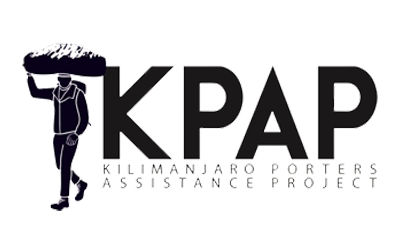
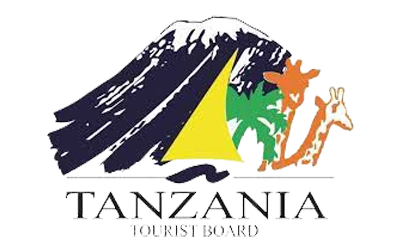
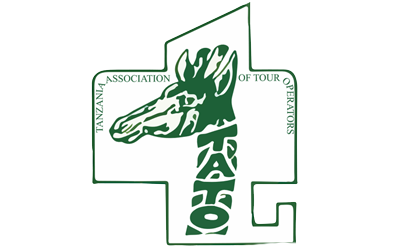
© 2023 Safari Nuggets – All Rights Reserved.

